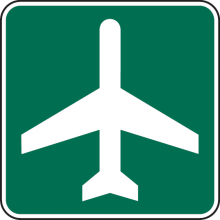
Airports in the United States range from small non-towered facilities for general aviation up to large international hubs. Large airports are critical destinations for Waze users, due to traffic volume, complexity of roadways and the time-sensitive nature of commercial air travel. Regardless of size, this page will explain how to properly map, name and select stop points for airports and various other places within them, so that Waze users can quickly search and obtain accurate navigation for where they need to be, and so that airports display sensibly on the map.
The main area place
Each airport should be drawn as a single area place, covering all the airport property and including any runways, taxiways, terminal buildings, control towers or other structures. This will ensure visibility on the map.
Names
Primary name
Airports are referred to in various ways, using official names, abbreviated names, acronyms and location identifier codes. Official names are often long (e.g. Hartsfield-Jackson Atlanta International Airport), and so they are often abbreviated on signage and in local use (e.g. Atlanta Airport or ATL). Use the official, long-form name as the primary name of the airport. This will create the most straightforward and uniform display on the map, and since airports always occupy a large area, the length of the name does not cause display problems.
Alternate names
All airports in the United States have a location identifier assigned by the Federal Aviation Administration (FAA), which is three alphabetical or alphanumeric characters for public-use airports and four alphanumeric characters for private-use airports. Many public-use airports also have a four-letter location indicator from the International Civil Aviation Organization (ICAO). In the contiguous United States ICAO prefixes K to the alphabetical FAA identifier of an airport to create its ICAO code. In Alaska, Hawaii and US territories ICAO codes begin with other letters and are not directly related to the FAA identifier. Finally, most airports with commercial passenger operations in the US are assigned a three-letter identifier by the International Air Transport Association. This is often, but not always, identical to the FAA identifier. Since IATA codes are used by airlines in flight schedules and baggage handling, they are the most well-known airport codes. To aid users in searching, add at least one location identifier as an alternate name:
- If the airport has an IATA code, use that as an alternate name.
- If the airport does not have an IATA code, but it has an ICAO indicator, use both the ICAO indicator and the FAA identifier as alternate names.
- If the airport has neither an IATA nor an ICAO code, use the FAA identifier as the alternate name.
In addition to location identifiers, if an airport has a commonly used local abbreviation, such a DIA for Denver International Airport, include that as an alternate name as well.
Stop point
The stop point for the airport should be placed as follows:
- If the airport has one terminal accessible by one road, place the stop point at the terminal.
- If the airport has one entrance and multiple terminals or one terminal with multiple traffic levels, place the stop point at a location before any of the individual paths branch from the entrance road.
- If the airport has multiple entrances, place the stop point at a location that is most helpful to the most passengers at the airport.